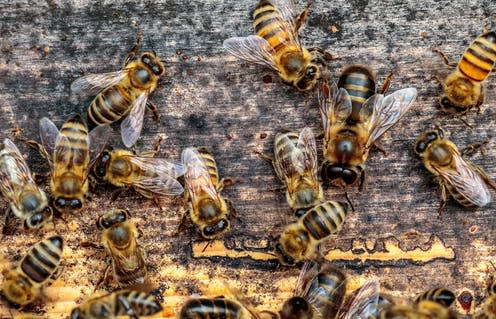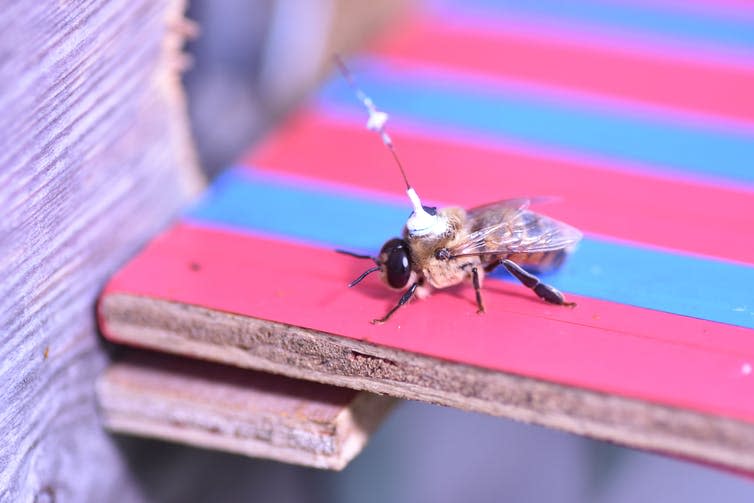We tracked male honeybees for two years to find out where they look for sex

Honeybees pollinate a lot of our food crops, they’re welcome visitors to our gardens and they are widely kept throughout the world – so much so that some have described them as a domesticated species.
It may come as a bit of a surprise, then, to discover there are big gaps in our knowledge regarding where honeybees mate. The problem is that bees mate in mid-air, possibly up to 50 metres above the ground, where it’s almost impossible to observe them.
This is why my colleagues and I spent two years trying to track the flight paths of male honeybees, known as drones. We’ve published the results in a new study which helps solve the longstanding mystery of where honeybees mate.
Drones are born in summer and have one aim in life – to mate with a virgin queen. New queens make up to six nuptial flights at the start of their lives, during which they mate with six to 24 different drones. They store the sperm, which they use to fertilise all the worker eggs they lay for the rest of their lives – more than 1,000 per day.
Where do the drones go?
From a few days old until they die, at around three weeks old, drones leave the hive several times a day looking for sex. But where do they go?
The first clue came more than 200 years ago, when the naturalist Gilbert White wrote of hearing a buzzing on his estate in England. Many beekeepers and scientists believe White was hearing the sound of thousands of drones coming together at a place known as a drone congregation area.
Scientists have investigated these supposed congregations by raising a long pole or balloon with either a queen bee in a cage or a “lure” – some cotton wool soaked in the pheromones that queens produce.
A trail of drones will often form downwind, competing to try to mate with the queen. One problem with this technique is, because drones are attracted to the lures, we can’t know for sure how they’d behave when the lures aren’t there. Some people suspect the congregations might be created by the scientists themselves.
In the early 1990s, scientists in Arizona, US, used a radar to monitor drone movements at a large bee farm. They couldn’t track individual bees but their observations seemed to show drones followed shared routes. We wanted to know more, so we set out to use a different type of radar to reveal the movements of individual drones.

Tracking bees
To track the bees we attached small pieces of electronic equipment, known as transponders, to their thorax. Our radar rotated once every three seconds, “illuminating” its surroundings with a beam of radio signals. When these hit a transponder, they were converted into an answering signal. The radar constantly scanned for these incoming signals, allowing us to work out the position of the bee.
The first thing we noticed was our drones switched between two forms of flight. They used straight, efficient flights between places but often switched to circling, looping flight. We found these convoluted flights were clustered in four specific areas – even without lures to attract them, drones cluster in congregation areas.
We looked more carefully at the flights in congregation areas and found a pattern. The further they flew from the centre of the area, the more strongly they accelerated back toward it. Imagine marbles sloshing around in the bottom of a steep sided bowl, starting to climb the sides only to speed back to the middle. This pattern of accelerations, also seen in swarming midges, simulates a physical force, keeping the bees bound together and maintaining a cohesive swarm.

Why would so many drones come together like this? The most likely explanation is congregations are a form of “lek” – leks are large groups of male animals who gather to attract a mate. They are common among birds and mammals, where males often put on elaborate displays to attract picky females.
There are several possible reasons why leks might have evolved, but the one most likely to apply to bees is that males gather in places that females are likely to visit. This allows males and females to rendezvous without having to search the entire landscape – a tough proposition when you’re as small as a bee.
One major difference between bees and other animals was our bees frequently flew between drone congregation areas, staying for only a few minutes at each, whereas lekking animals are typically very faithful to a single location.
The big puzzle is how drones find these areas. Our results showed that congregation areas will attract bees for at least two years, but no individual drone lives long enough to pass on knowledge about how to find them to the next generation.

We followed some drones from the first time they left the nest, through many subsequent flights. On their first flights, they stayed close to the hive, learning its appearance to find their way home again, but never visited congregations. Some visited congregation areas on their next flights, though, and managed to fly straight there without searching for it.
Whatever signs they use to guide themselves must be obvious from close to the hives and, because drones from different hives visited the same locations, must be observable no matter where they are. We plan to use a 3D model of the entire field site to reconstruct what our drones could see as they flew to the congregations, to find out what they looked to for guidance.
Understanding drones’ mating behaviour will help beekeepers manage their breeding programs and help us unravel a longstanding mystery about bee behaviour. I’m also part of a project taking inspiration from bees to create a new generation of autonomous robots. As we start to understand how bees can accomplish complicated behaviours, we could develop robots that work with less human guidance.
This article is republished from The Conversation under a Creative Commons license. Read the original article.

Joseph Woodgate has recieved funding from the Engineering and Physical Sciences Research Council (Program Grant Brains-on-Board, EP/P006094/1 and the European Research Council (Advanced Grant no. 339347: SpaceRadarPollinator).

